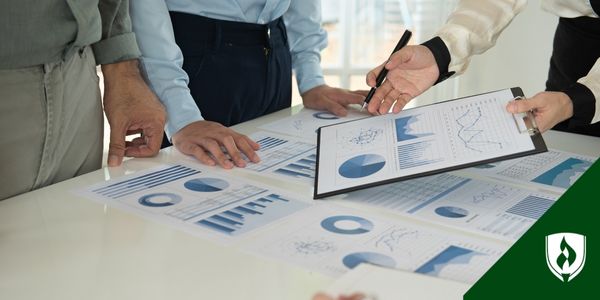Data Science vs Data Analytics: Key Differences
05/22/2025

When considering careers that involve working with data, two popular paths are often mentioned: data science and data analytics. Both fields present exciting opportunities and high demand, but they differ in their roles, responsibilities, and required skills. Understanding the key differences between data science and data analytics can help you choose the path that aligns with your career goals.
Understanding the Role of Data Science
Data science is a field that includes several disciplines, such as data analytics, data engineering, and machine learning. It involves using data to develop statistical frameworks that anticipate future behaviors. Data science1 is a career that typically requires knowledge of machine learning, artificial intelligence (AI), and big data systems.
In data science, professionals often work with both structured and unstructured data. They perform tasks such as data cleaning, data mining, and building predictive models that identify patterns and forecast future trends. Data scientists often possess a thorough understanding of computer science and are skilled in programming languages such as Python®, R®, and SQL®.
What Is Data Analytics?
On the other hand, data analytics focuses on examining existing data to generate insights that inform business decisions. It typically involves statistical analysis and the use of data visualization tools like Tableau® or Power BI® to present findings in a way that’s easy to understand for colleagues and stakeholders.
While data science deals with complex models and machine learning, data analytics focuses more on descriptive analytics. Professionals in this field use structured data like databases and spreadsheets to analyze business performance and suggest improvements.
Career Paths in Data Science and Analytics
To better understand the opportunities available in both fields, here are a few specific roles and responsibilities of professionals in data science and data analytics:
Data Analyst
A data analyst2 plays a key role in supporting data interpretation that may inform business decisions based on that information. Analysts focus on analyzing data to identify trends and present insights using data visualization tools. Their work often involves data collection, organizing data, and making it accessible for stakeholders.
Essential skills for a data analyst may include:
- Strong analytical and problem-solving skills.
- Statistical analysis and data visualization tools like Excel®, Tableau®, or SQL®.
- Understanding of data management and creating clear reports for stakeholders.
Data Scientist
A data scientist3 typically goes beyond traditional data analysis and focuses on engineering data-driven systems and training machine learning models to uncover complex patterns to solve complex problems. They handle both structured and unstructured data to create solutions that forecast trends, automate decision-making, and generate deeper insights from large amounts of data.
Key skills for a data scientist may include:
- Machine learning and predictive analytics.
- Programming languages like Python®, R®, and SQL®.
- Knowledge of big data platforms and data integration techniques.
Data Science vs Data Analytics: Key Differences
To better understand the distinctions between data science and data analytics, here’s a side-by-side comparison:
| Aspect | Data Science | Data Analytics |
|---|---|---|
| Definition | A broad field that includes machine learning, predictive modeling, and data engineering. | Focuses on analyzing historical data to extract actionable insights. |
| Focus | Building predictive models and algorithms to forecast future outcomes. | Analyzing existing data to inform decisions and solve business problems. |
| Key Responsibilities | Develop machine learning models, build data pipelines, and create predictive systems. | Analyze data, create reports, and visualize findings to support decision-making. |
| Skills | Expertise in programming languages (e.g., Python®, R®), machine learning, big data platforms. | Strong statistical analysis, proficiency in tools like Excel®, Tableau®, SQL®, and data visualization. |
| Data Type | Works with both structured and unstructured data (e.g., text, images, video). | Primarily deals with structured data (e.g., spreadsheets, databases). |
| Tools Used | Machine learning algorithms, big data platforms (e.g., Hadoop®, Spark®), Python®, R®. | Statistical tools (e.g., Excel®, SQL®), Tableau®, Power BI®, Google Analytics®. |
| Common Job Titles | Data Scientist, Machine Learning Engineer, Data Engineer. | Data Analyst, Business Intelligence Developer, Data Quality Analyst, Systems Engineer |
| Common Industries | Technology, finance, healthcare | Retail, marketing, operations |
Education and Training for Data Careers
While both fields require a solid foundation in statistics and data management, the educational paths differ.
Data science uses statistical analysis and algorithms, so it's common for students to pursue degrees in mathematics, statistics or computer science. Data scientists4 typically need a master's degree or Ph.D., particularly if they want to specialize in areas like machine learning or big data platforms.
Data analysts, however, typically need a bachelor's degree in fields like business analytics, statistics, or information technology, and can develop additional data analysis skills through certifications and professional experience.
Rasmussen University offers an online bachelor's degree in data analytics5, which aligned with SAS® Joint Certificate program. The SAS® Joint Certificate is awarded to students who successfully complete the required courses. Availability and requirements may vary.
By completing three specific courses, students earn the Data Analytics SAS® Joint Certificate and gain practical skills for solving business problems.
Skills gained through the Rasmussen University Data Analytics program may include:
- Data extraction
- Data manipulation
- Data analysis
- Data visualization
Job Outlook for Data Careers
The demand for data scientists and data analysts remains strong, with both fields projected to grow substantially in the coming years.
According to the Bureau of Labor Statistics, the need for data professionals is projected to grow3 36% from 2023-2033.
Which Career Path Is Right for You?
The decision between data science and data analytics ultimately depends on your interests, skills, and career goals. If you are more interested in building predictive models, working with machine learning algorithms, and solving complex data problems, data science could fit.
If your focus is on analyzing existing data and using that information to guide business intelligence and operational decisions, becoming a data analyst might be the right path for you.
Graduates with skills in these areas may find opportunities across a range of industries, depending on employer needs and individual experience. By understanding the key differences and how they align with your career goals, you can choose the path that best suits your skills and aspirations.
SAS and all other SAS Institute Inc. product or service names are registered trademarks or trademarks of SAS Institute Inc. in the USA and other countries. ® indicates USA registration.
Python® is a registered trademark of the Python Software Foundation.
R® is a registered trademark of the R Foundation.
SQL® is a registered trademark of the American National Standards Institute (ANSI) and the International Organization for Standardization (ISO).
Excel® is a registered trademark of Microsoft Corporation in the United States and/or other countries.
Tableau® is a registered trademark of Tableau Software, LLC.
Power BI® is a registered trademark of Microsoft Corporation in the United States and/or other countries.
Google Analytics® is a registered trademark of Google LLC.
Hadoop® is a registered trademark of The Apache Software Foundation.
Spark® is a registered trademark of The Apache Software Foundation.
SAS® is a registered trademark of SAS Institute Inc. in the USA and other countries.
1Bureau of Labor Statistics, U.S. Department of Labor, Occupational Outlook Handbook, Data Scientists, at https://www.bls.gov/ooh/math/data-scientists.htm#tab-2 (visited Mar. 24, 2025).
2Rasmussen University, What Does a Data Analyst Do?, at https://www.rasmussen.edu/degrees/technology/blog/what-does-a-data-analyst-do/ (visited Mar. 24, 2025).
3Bureau of Labor Statistics, U.S. Department of Labor, Occupational Outlook Handbook, Data Scientists, at https://www.bls.gov/ooh/math/data-scientists.htm#tab-6 (visited Mar. 24, 2025).
4Bureau of Labor Statistics, U.S. Department of Labor, Occupational Outlook Handbook, Data Scientists, at https://www.bls.gov/ooh/math/data-scientists.htm#tab-4 (visited Mar. 24, 2025).
5Rasmussen University, Bachelor’s Degree in Data Analytics, at https://www.rasmussen.edu/degrees/technology/data-analytics/bachelors/ (visited Mar. 24, 2025).



